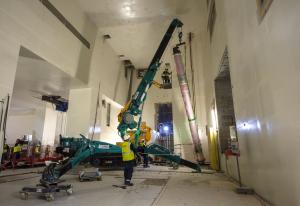Now the vertical spools
At the L3 level of the Tokamak Building, ceiling height in some galleries exceeds 10 metres. But when it comes to lifting a cryoline spool, tilting it 90 degrees and inserting it into a vertical shaft that connects to lower levels, this headroom turns out to be barely sufficient.
The cryolines form a five-kilometre network of sophisticated piping that originates in the ITER cryoplant before crossing over a bridge to the Tokamak Complex to distribute cooling fluids to the tokamak's components and systems.
The better part of the network ends up in the basement of the building (B2 level), where it branches out in two directions: laterally towards the magnet feeders and up overhead through vertical shafts to the auxiliary cold boxes located at L3 level.
Cryoline installation at the B2 level, which began in September 2019, is now complete. On Tuesday 16 June, the first spool of the vertical "lines" connecting to the L3 level was successfully inserted into the south shaft. The south shaft will accommodate two lines; at the opposite end of the gallery, the north shaft will accommodate five. All will connect to the auxiliary cold boxes that will be installed in 2022.
When everything is in place, the system will be able to feed a constant flow of cooling fluids to the different "clients" inside the machine: 25 tonnes of supercritical helium at 4 K (minus 269 °C) to 10,000 tonnes of superconducting magnets plus cryopumps, and gaseous helium at 80 K (minus 193 °C) to the thermal shield.


